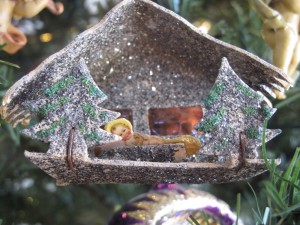Christmas Eve is a particularly busy and special time in clergy households. The whole day focuses toward the services that mark this night in a profound and intense way that is hard to explain to others. Everything else becomes peripheral to that worship and the preparation for it. No matter how stressed the days leading to this moment, the sense of love incarnate becomes very tangible as darkness falls and candles are lit.
 I have certain touchstones that are literal examples of that love. One is the tiny creche that hung on my mother’s Christmas tree from the time she was a little girl and then was gifted to me from the family tree in 1975. If you look closely, you can see that the baby is holding a cross – a profoundly unsettling understanding of the incarnation that has slowly slipped deeper and deeper into the background of Christmas during my lifetime.
I have certain touchstones that are literal examples of that love. One is the tiny creche that hung on my mother’s Christmas tree from the time she was a little girl and then was gifted to me from the family tree in 1975. If you look closely, you can see that the baby is holding a cross – a profoundly unsettling understanding of the incarnation that has slowly slipped deeper and deeper into the background of Christmas during my lifetime.
And, how sad, because if this birth shows us anything, it is that everything that is caught in this miracle called time, shares not only brokenness, trials, tribulations, pain, suffering and, eventually, death, but shares beauty, grace, hope, vision, and the divine image, as well. Like the One we honor, we are incarnate love. Like the new-born holding the symbol of death, we exist in a paradoxical holy time. As the earth swings the last one-billionth of a degree of its arc, pauses motionless for a nanosecond, and then tips inexorably toward the summer solstice, we pause motionless between inhale and exhale, on the liminal cusp where birth and death are one, time and eternity are one, all that is immanent and all that is transcendent are one.
Another touchstone is the following greeting (known as the Fra Giovanni Prayer) which was printed in our holiday cards for many years and which my husband and I also used in the Christmas Eve candlelight services during our ministry in western Massachusetts. The attribution, such as we have it, appears at the end.
There is nothing I can give you which you do not have,
but there is much that while I cannot give it, you can take.
No heaven can come to us unless our hearts find rest in today. Take heaven.
No peace lies in the future that is not hidden in this present instant. Take peace.
The gloom of the world is but a shadow; behind it, yet within reach, in joy.
There is radiance and glory in the darkness could we but see – and to see we have only to look.
I beseech you to look.
 Life is so generous a giver,
Life is so generous a giver,
but we judging its gifts by their covering,
cast them away as ugly or heavy or hard.
Remove the covering
and you will find beneath it a living splendor,
woven of love, by wisdom, with power.
Welcome it, grasp it,
and you touch the angel’s hand
that brings it to you.
Everything we call a sorrow or a duty,
the angel’s hand is there, the gift is there,
and the wonder of an overshadowing presence.
Our joys, too, be not content with them as joys.
They, too, conceal diviner gifts.
And so at this time I greet you,
not quite as the world sends greetings,
but with profound esteem
and the prayer that for you, now and forever,
the day breaks and the shadows flee away.
Blessings in this Solstice Time,
–Andrea
Fra Giovanni Giocondo (c.1435–1515) was a Franciscan friar who was a true Renaissance man: an architect and engineer, archaeologist, and classical scholar. His name is associated with a letter purported to have been sent by him to Countess Allagia Aldobrandeschi on Christmas Eve, 1513. The prayer can only be traced as far back as the 1930s when it was included in a Christmas greeting from Greville MacDonald (son of author George MacDonald).
Text © 2014, Andrea La Sonde Anastos
Photos © 2014 Immram Chara, LLC
NOTE: The creche in the first photo was probably made in the late 1920s or early 1930s. The lion and lamb in the second photo was a gift to my husband following the birth of our daughter. She and I added the feathers many years later so that it could be included the Christmas that we decorated the tree only in flying things.